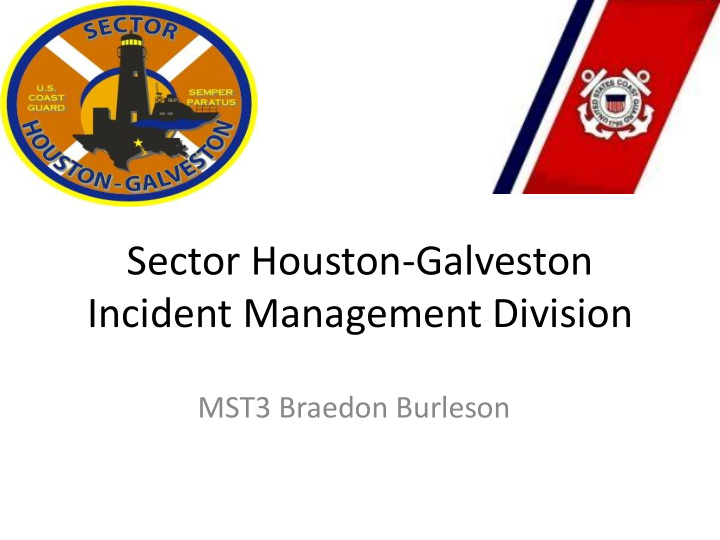



Sector Houston-Galveston Incident Management Division MST3 Braedon Burleson
11 Coast Guard Missions • By law, the Coast Guard has 11 missions: • Ports, waterways, and coastal security • Drug interdiction • Aids to navigation • Search and rescue • Living marine resources • Marine safety • Defense readiness • Migrant interdiction • Marine environmental protection • Ice operations • Other law enforcement
Our office 11 Pollution Responders 5 Federal On-scene Coordinators (FOSCR) 2 Officers: Lieutenant Commander Kevin Boyd, Chief Incident Management Division LTJG Denys Rivas, Assistant Chief Incident Management Division 10 Petty Officers: Chief Marine Science Technician Matthew White, Incident Management Division Bullpen Chief Teams are on call 24/7
Operations Overview • 2013 Numbers: 200-250 Pollution responses 3 Federally funded responses
Sector Houston-Galveston AOR
AOR per EPA MOU
Our Mission: Marine Environmental Protection • Respond to oil discharges, and hazardous material releases (Actual or Potential) in the Navigable Waters of the United States. • Investigate and identify responsible parties. In the absence of a Responsible Party, the federal government (FOSCR) assumes financial and operational oversight of the incident. • Supervise all cleanup operations and setup Incident Command Structure, if necessary. • Assess financial penalties to Responsible Parties. • Determine clean up endpoints with Responsible Parties.
Authority The Laws… Refuse Act Federal Water Pollution Control Act Clean Water Act (amendment to FWPCA) Oil Pollution Act of 1990 (amendment to FWPCA) CERCLA – Comprehensive Environmental Response Compensation and Liability Act Superfund Amendment and Reauthorization act – SARA (amendment to CERCLA)
Federal Water Pollution Control Act Reactionary Law Happens in result of an incident Result of the T/V Torrey Canyon 1967 discharge of 860,000 barrels of Kuwait crude oil off the coast of England Cuyahoga River that caught Fire River caught fire due to oil/hazmat and contaminated debris floating on it
Goals of FWPCA There were two main goals of this law - Attain a “safe” water quality level Eliminate all water pollution by the year 1985 The purpose of this law was to prohibit the discharge of Oil and Hazardous Substances in harmful quantities into the navigable waterways of the U.S.
Parts of the FWPCA – 5 Elements Discharge Of oil or hazardous substance In a quantity that may be harmful or a reportable quantity Into a navigable waterway of the U.S. With a Responsible Party
Differences between Oil Discharge and Hazardous materials release • Oil discharge – 40 CFR112.2 Discharge includes, but is not limited to, any spilling, leaking, pumping, pouring, emitting, emptying, or dumping of oil, but excludes discharges in compliance with a permit under section 402 of the CWA – Harmful Quantity Cause a film or sheen upon or discoloration of the surface of the water or adjoining shorelines or cause a sludge or emulsion to be deposited beneath the surface of the water or upon adjoining shorelines
Differences between Oil Discharge and Hazardous materials release • Hazardous material release – Release means any spilling, leaking, pumping, pouring, emitting, emptying, discharging, injecting, escaping, leaching, dumping, or disposing into the environment (including the abandonment or discarding of barrels, containers, and other closed receptacles containing any hazardous substance or pollutant or contaminant) – A release must exceed the Reportable Quantity for that given Hazardous Substance listed in 40CFR117.3 and 40CFR302.4
Difference between Coastal and Inland zones 40CFR 300.5 • Coastal zone as defined for the purpose of the NCP, means all United States waters subject to the tide, United States waters of the Great Lakes, specified ports and harbors on inland rivers, waters of the contiguous zone, other waters of the high seas subject to the NCP, and the land surface or land substrata, ground waters, and ambient air proximal to those waters. The term coastal zone delineates an area of federal responsibility for response action. Precise boundaries are determined by EPA/USCG agreements and identified in federal regional contingency plans. • Inland zone means the environment inland of the coastal zone excluding the Great Lakes and specified ports and harbors on inland rivers. The term inland zone delineates an area of federal responsibility for response action. Precise boundaries are determined by EPA/USCG agreements and identified in federal regional contingency plans.
Incident Response • Incident occurs… Responsible party or 3 rd Party Notifies • the National Response Center (NRC) • NRC forwards report to all area response entities. • USCG Local Command centers receive report and notifies our office. • 2 person team is on Call 24/7 conducts investigation; determines size and cause of the incident; makes clean up recommendations and supervises clean up operations.
Federally Funded Responses • Oil Spill Liability Trust Fund • CERCLA Fund (Superfund)
Partner Agencies with Overlapping Authorities and Responsibilities Federal EPA BSEE (Bureau of Safety and Environmental Enforcement) NOAA ACOE (Army Corps of Engineers) Department of Interior State TGLO Texas General Land Office TCEQ Texas Commission of Environmental Quality TXRRC Texas Rail Road Commission TX P&W Texas Parks and Wildlife Countless local emergency response entities(Fire Departments, Offices of Emergency Management, and Police Departments etc.)
Failure of Responsible Party to report a spill is illegal • 33CFR153 , 40CFR 33CFR153 , 40CFR110 & 40CFR116 110 & 40CFR116 THE NATIONAL RESPONSE CENTER 1-800-424-8802
How to get in contact with us • Office: 281-464-4898 • 24 hr Command Center: 713-464-4855 • NRC: 1-800-442-8802 • E-mail: IMDHouston@uscg.mil
Questions?
Recommend
More recommend